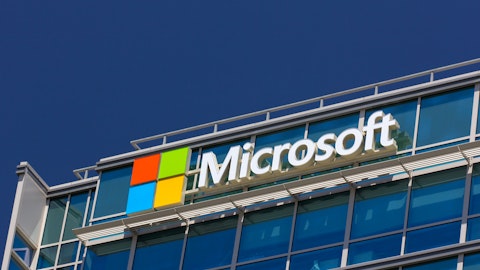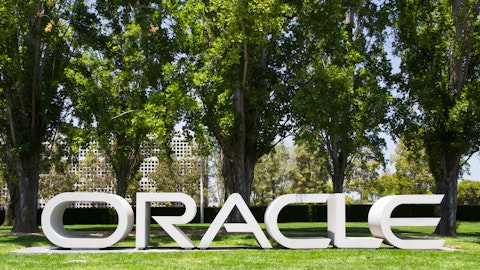Oracle Corporation (NYSE:ORCL) Q3 2023 Earnings Call Transcript March 9, 2023
Operator: Good afternoon. My name is Emma, and I will be your conference operator today. At this time, I would like to welcome everyone to the Oracle Corporation’s Third Quarter 2023 Earnings Call. Ken Bond, Senior VP of Investor Relations, you may begin your conference.
Ken Bond: Thank you, Emma. Good afternoon, everyone, and welcome to Oracle’s third quarter fiscal year 2023 earnings conference call. A copy of the press release and financial tables, which includes a GAAP to non-GAAP reconciliation and other supplemental financial information, can be viewed and downloaded from our Investor Relations website. Additionally, a list of many customers who purchased Oracle Cloud Services or went live on Oracle Cloud recently will be available from the Investor Relations website. On the call today are Chairman and Chief Technology Officer, Larry Ellison; and CEO, Safra Catz. As a reminder, today’s discussion will include forward-looking statements, including predictions, expectations, estimates or other information that might be considered forward-looking.
Throughout today’s discussion, we will present some important factors relating to our business, which may potentially affect these forward-looking statements. These forward-looking statements are also subject to risks and uncertainties that may cause actual results to differ materially from statements being made today. As a result, we caution you against placing undue reliance on these forward-looking statements, and we encourage you to review our most recent reports, including our 10-K and 10-Q and any applicable amendments for a complete discussion of these factors and other risks that may affect our future results or the market price of our stock. And finally, we are not obligating ourselves to revise our results or these forward-looking statements in light of new information or future events.
Before taking questions, we’ll begin with a few prepared remarks. And with that, I’d like to turn the call over to Safra.
Safra Catz: Thanks, Ken, and good afternoon, everyone. Q3 represented another great quarter with continued momentum on the top and bottom line. But before I get to the numbers, I want to share with you a few thoughts that explain what’s behind our continued financial success. First, our cloud offerings drive operational efficiency. In fact, one of our competitors recently coined the term, the Oracle playbook, which I absolutely love, because the Oracle playbook is all about doing more while spending less. As you all know, we started this ourselves over 20 years ago and have kept it up over all these years, resulting in the highest margins in the software business for decades. Using our own products and services enables us to increase our investments for growth, while also growing profitability, including through acquisitions as well as during our move to the cloud.
We are constantly talking with our customers about leveraging Oracle technology to accelerate their speed to market and reduce cost, all the while improving the experience they deliver to their customers. The combination of Oracle’s infrastructure and apps, which is unique in the cloud market, increases the intensity of business transformation. Cloud is no longer about just renting commodity white boxes. It’s about velocity and value. We have become the enterprise technology vendor of choice because we have products and services that help our customers drive cost efficiencies and modernize their businesses. Second, while AI has been dominating the recent news cycle, the truth is that our Fusion and Infrastructure customers have been using AI as an integral part of their business for some time.
Oracle Fusion, with embedded AI, enables customers to close their books in days, not weeks. Oracle AI provides more relevant sales leads. Oracle AI increases infrastructure performance and security with no human intervention. And customers using OCI get AI as a service to help drive their own business transformation. Given our scale and our information advantage across industries and technologies, we are constantly training our applications to do more for our customers, whether it’s further what our customers get when they use our platform. And on our Gen 2 OCI platform, the architecture and unique network capability has fast become the platform of choice for many AI companies because OCI runs workloads faster. And time is money in the cloud.
So coming to us saves our customers money. Third, customers are putting Oracle’s comprehensive and powerful ways to accelerate their businesses. The Uber win was notable because we have yet another example of an industry-transforming company concluding that Oracle’s cloud, performance and security exceeds that of our competitors and at a price point that represents a sustainable long-term partnership. Uber will use more of our technology to drive value in their own business. And you’re going to see a rising list of these types of strategic wins pile up in the quarters to come. Finally, before I move to the numbers, and hopefully, no one missed this fact, that we’re announcing our earnings nine days after the close of the quarter, and we expect to file the Q right away.
We continue to set the standard in operating efficiency which helps customers see what’s possible when they are working with us. Okay. Now to the Q3 results. As always, I’ll discuss them using constant currency growth rate to provide a full picture both organically and otherwise, I’m going to go over the revenue results, including Cerner, and then some revenue results excluding Cerner. Total cloud revenue, that’s SaaS plus IaaS, including Cerner, was $4.1 billion, up 48% in constant currency, with IaaS revenue of $1.2 billion, up 57% and SaaS revenue of $2.9 billion, up 44%. Now excluding Cerner, total cloud revenue was up 28% in constant currency at $3.5 billion. Total cloud services and license support revenue for the quarter, including Cerner, was $8.9 billion, up 20% in constant currency, driven again by our strategic cloud applications, autonomous database and our Gen 2 OCI.
Application subscription revenues, which includes support, were $4.2 billion and up 33% in constant currency. Infrastructure subscription revenues, also including support, were $4.8 billion, up 10% in constant currency. Application subscription revenues, including support but excluding Cerner, were $3.4 billion, up 8% in constant currency. SaaS cloud revenue, again, excluding Cerner, was $2.3 billion and was up 16%. Our strategic back-office SaaS applications now have an annualized revenue of $6.2 billion and grew 25% in constant currency, including Fusion ERP, up against 28% and NetSuite ERP, up 26% this quarter. As mentioned already, infrastructure cloud services revenue was up 57% in constant currency. And when you exclude our legacy hosting services, infrastructure cloud services revenue grew 65%, with an annualized revenue of $4.4 billion, including OCI consumption revenue, which was up 86%, cloud customer consumption revenue, up 73%, and autonomous database, up 50%.
Database subscription revenues, which include database support, were up 3% in constant currency, highlighted by cloud database services, which were up 40%. Database’s subscription revenue is largely made up of on-premise database support. But as these databases migrate from on-premise to the cloud and cloud customer, we expect these cloud database services will be the third leg of revenue growth alongside back-office SaaS and Gen 2 OCI cloud services. Software license revenue, including Cerner, were $1.3 billion, up 4% in constant currency. So all in, total revenues for the quarter were $12.4 billion, up 21% in constant currency. Excluding Cerner’s contribution of $1.5 billion, organic revenue was up 7% in constant currency. As a reminder, we no longer operate in Russia, causing organic revenue growth to be negatively affected by 1% of growth over last year.
Shifting to margins. The gross margin for cloud services and license support was 79% as a result of the mix between support and cloud. Last year, Oracle license support revenue with its mid-90s gross margins represented about 63% of cloud services and license support revenue. Now because our cloud services are growing so fast, it’s down to 55%. Additionally, I would note that IaaS gross margins improved substantially from last year, and I expect IaaS gross margins will continue to improve. While we have continued to build data center capacity, we’ve also seen our margins go higher as these new cloud regions fill up. Most importantly, gross profit dollars of cloud services and license support grew 13% with Cerner and 6% excluding Cerner. Non-GAAP operating income was $5.2 billion, up 11% from last year.
The operating margin, including Cerner, was 42% as we continue to integrate Cerner in the quarter As we drive Cerner profitability to Oracle standards and continue to benefit from economies of scale in the cloud, we will not only continue to grow operating income, but we will also grow the operating margin percentages. For example, while we have only owned Cerner for three quarters, we have already improved its operating margin by over 5 percentage points compared to before the acquisition. And by the way, I actually expect this year, FY 2023, the one we are closing out in one more quarter, will be the trough year for operating margins and percentages as our margin improvement initiatives play out. The non-GAAP tax rate for the quarter was 18.4% and non-GAAP EPS was $1.22 in U.S. dollars, up 8% in USD, up 13% in constant currency.

Photo by Dylan Gillis on Unsplash
GAAP EPS was $0.68 in U.S. dollars. At quarter end, we had nearly $8.8 billion in cash and marketable securities. The short-term deferred revenue balance was $8.6 billion, up 14% in constant currency. Over the last four quarters, operating cash flow was $15.5 billion, and free cash flow was $7.3 billion with capital expenditures of $8.2 billion. Operating cash flow for the quarter was up 11% at $4.3 billion. The remaining performance obligation or RPO balance is $62.3 billion, up 66% in constant currency due to strong cloud bookings as well as Cerner, which Larry will discuss in a moment. I will also note that the organic RPO growth rate was 26% in constant currency. Approximately 48% of total RPO is expected to be recognized as revenue over the next 12 months.
CapEx this quarter was $2.6 billion as we continue to build capacity for existing bookings and our customers’ growing needs. Given the demand you see reflected in the RPO as well as what we see in our pipeline, I expect that our CapEx investments will be about where it is right now for the foreseeable future. As always, we remain careful to pace our investments appropriately and in line with booking trends. We now have 41 public cloud regions around the world with another 8 being built. In addition, 12 of these public cloud regions interconnect with Azure, giving customers true multi-cloud capabilities. We have many cloud customer implementations, 10 dedicated regions and another 9 national security regions with increasing demand for more. As we’ve said before, we are committed to returning value to our shareholders through technical innovation, strategic acquisitions, stock repurchases, prudent use of debt and a dividend.
This quarter, we repurchased 1.8 million shares for a total of $150 million. In addition, we paid out dividends of $863 million in the quarter. And the Board of Directors increased the quarterly dividend 25% from $0.32 to $0.40 per share. Our financial strategy remains focused on growing non-GAAP operating and pre-tax income while substantially increasing cloud revenue growth. And given increasing customer interest in our cloud technologies, we will continue to prudently invest to meet this demand. As a reminder, because now we’re going to talk about Q4, last Q4, we had a spectacular double-digit revenue growth rate, highlighted by 25% constant currency growth in software license. With our continued migration to the cloud, we expect that we will continue to win big deals that are more subscription driven than license driven.
These big subscription wins add to the backlog and are recognized over time rather than upfront. That is exactly what we want to see as our cloud business continues to see excellent growth. So now let me turn to my guidance for Q4, which I’ll provide on a non-GAAP basis. Now assuming the currency exchange rates remain the same as they are now, currency would have a 2% negative effect on total revenue and at least 3% plus negative effect on EPS in Q4. But as I say every quarter, the actual currency impact may be very different by quarter end. Okay. Here we go. Total revenues for Q4, including Cerner, are expected to grow from 17% to 19% in constant currency, and thus are expected to grow 15 to 17 in USD. Total cloud growth, including Cerner, is expected to grow from 51% to 53% in constant currency, 49 to 51 in USD.
I expect total cloud growth for Q4, excluding Cerner, will be above 30% in constant currency. I expect growth in operating profit to be double digits. As you all know, my non-GAAP tax rate guidance is typically 20.5. However, our tax rates over the last two years and Q4 have averaged around 11%, and I anticipate that in Q4, the most likely outcome is a non-GAAP tax rate of around 14.5%. And we’ve used this rate in determining our EPS guidance for Q4. Now mind you, that’s comparing it to 11 or 10.5, I think, last year. Regardless, like past quarters, the actual tax rate for Q4 could be higher or lower and affect our actual EPS. With that, non-GAAP EPS is expected to grow between 3% and 5% and between $1.59 and $1.63 in constant currency. Non-GAAP EPS is expected to grow between 1% and 3% and be between $1.56 and $1.60 in USD.
What have I got here? Anyway, as I’ve said before, Cerner will be accretive to earnings this year, including Q4. And with that, I’ll turn it over to Larry for his comments.
Larry Ellison: Thank you, Safra. Since June of last year, when we acquired Cerner, that business has increased its health care contract base by approximately $5 billion. We have signed a diverse set of new and expanding domestic and international customers, including the U.S. Department of Defense, the U.S. Department of Veterans Affairs, hospital groups in a dozen U.S. states, multiple hospitals in the United Kingdom, multiple provinces in Canada, the Australian Defence Forces, multiple hospitals in Puerto Rico and multiple countries in the Middle East. While we are pleased with this early success of the Cerner business, we expect the signing of new health care contracts to accelerate over the next few quarters. Well, the Cerner business has been booking billions of dollars in Millennium Clinical and electronic health record systems for hundreds of hospitals and ambulatory clinics.
The overall Oracle Healthcare application portfolio is actually much broader, covering virtually the entire health care ecosystem. Hospitals are also buying the Oracle Fusion ERP system to manage their revenue cycle and from reimbursements — from insurance companies to patient billing, plus their medical supply chain from ordering to inventory. Hospitals are buying Fusion HCM to manage their complex high-value workforce of doctors, nurses and technicians. Pharmaceutical companies are buying Oracle Clinical One to manage clinical trials. Government health organizations, public health organizations are using aggregated EHR data to monitor infectious disease and respond to outbreaks quickly and efficiently. Now I’d like to take a couple of minutes and go over a little more specifically some of the Cerner wins since we bought the company.
One was a huge win at Labcorp and Ascension Health to deploy a single lab information system domain for 96 separate hospital-based labs across 10 states. Another one in Puerto Rico, Auxilio Mutuo, is an all-new electronic health record footprint to deploy in a 600-plus bed academic private hospital, replacing Altera, Paragon with Cerner Millennium. Vandalia Health, formerly Charleston Area Medical Center, consolidated all their EMRs into a single unified domain and added four new hospitals. UHS modernized their revenue cycle, migrated to CareAware with the CareAware Cloud and — for their hospitals and ambulatory clinics. Banner Health implemented a complete revenue cycle management for their health business. The VA deployed our unified electronic health record system to 19 additional sites.
The Department of Defense deployed Oracle Cerner EHR to all the OCONUS locations in the Department of Defense, the U.S. Department of Defense. In the UK, at the National Health Service, Sheffield Teaching Hospital deployed the full suite of Cerner applications across three additional sites and the Sheffield Teaching Hospitals. The Princess Alexandra Hospital, also in the NHS, is a 430-bed hospital that added the full Cerner suite. Mubadala Health was the first Cerner Millennium client to move from the Cerner data center directly now to the OCI Cloud. As we move our Cerner patients from the Cerner data centers into the Oracle OCI Cloud, we expect to get much better security, much better reliability, much better performance and dramatically lower our costs of providing that cloud service.
OCI is just much more efficient than the Cerner data centers that we acquired. We’ve deployed the full EHR footprint, Cerner footprint to four Sheikh Khalifa Hospitals in the U.A.E. with a capacity of 1,200 beds, serving a population of 1.4 million citizens, again, in the U.A.E. The Australian Department of Defense, we delivered acute care capabilities and deployed an environment for all of the Australian Defence hospitals and field hospitals. In Canada, starting in Nova Scotia, we deployed a one-patient, one-record EHR system across the province for the citizens of Nova Scotia. One-patient, one-record, as you know, I’ve discussed a long time the fact that patient electronic health records are scattered across every provider they visit. That problem is now being solved in Nova Scotia by having a single unified patient record for every patient regardless of which provider they visit.
Their records are still all in one place. Same thing in Niagara Health, a new HR footprint to support delivery of care for 450,000 citizens, again, in Canada. Okay. I’m going to stop with that. I mean those are direct Cerner wins since we acquired Cerner. But on top of that, we have all of the — all of — if you will, the rest of the health care suite, which is made up of Oracle ERP, Oracle HCM, Oracle Clinical One for clinical trials. Oracle ERP for managing everything from procurement and inventory, the entire supply chain or HCM from managing the enormously complicated scheduling and paying of their professional workforce and doctors, nurses, technicians, et cetera. We’re very strong in this part of the business. Our customers include the Cleveland Clinic, who use our ERP system in their hospitals and our supply chain systems; the Mayo Clinic, also ERP, supply chain and HCM to manage the workforce; Mount Sinai Hospital, ERP, SCM and HCM; then Providence St. Joseph Health, ERP, SCM, HCM and actually — and CX customer engagement; Adventist Health, Adventist Health uses Oracle ERP, SCM, HCM and CX; Kaiser Permanente, a huge Oracle HCM user, to manage their workforce; the NHS in the UK, ERP and SCM; UnitedHealthcare, ERP and HCM; BlueCross BlueShield, ERP, HCM, HCM and CX; Humana, ERP and SCM; Highmark Health, ERP, SCM, all Fusion products or HCM; Health Care Service Corporation, you see a pattern here, ERP, HCM and CX; Independence Blue Cross, ERP and HCM; Bright Health Care, ERP.
Now in this past quarter, we had major wins at Ascension Health buying ERP, HCM, SCM and HCM, where the primary competitor in HCM was Workday. As we add specific features to manage the health care workforce to our HCM product, Oracle becomes more and more successful in selling our HCM products within the health care ecosystem. So our win rates are going up dramatically. Our sales cycles are going down. University of Texas Health in San Antonio was a big HCM win there. Labcorp bought ERP and HCM, where the competitor in ERP was SAP. And the — we won BlueRock Therapeutics, where they bought ERP, SCM and Fusion Analytic Warehouse. Again, the competitor there was SAP. And this, by the way, is a wholly owned subsidiary of Bayer AG. So it was nice to win in a German company, German-owned company, ICU — against SAP.
ICU Medical expanded their HCM for vascular therapy and oncology. Dexcom, ERP, EPM, SCM; Sitel, ERP, EPM, SCM, a winner over SAP. We had some huge go-lives in the quarter. Providence Health, huge SCM customer, rolled out to 12 additional ministries. The National Healthcare in the UK, supply — I have all the trust — all the trust hospitals are all now live with ERP. Baptist Healthcare has now 10,000 employees live on HCM; Texas Children’s Hospital, 21,000 employees live on HCM. Kelsey-Seybold Clinics are now completely live in HCM. I can go on and on, but rather than doing that, I’m just going to turn it over — back over to Safra.
Ken Bond: Thank you, Larry. Emma, if you could please poll the audience for questions?
See also 10 Penny Stocks with Insider Buying and 12 Dividend Kings To Buy For Safe Dividend Growth.
Q&A Session
Follow Oracle Corp (NYSE:ORCL)
Follow Oracle Corp (NYSE:ORCL)
Operator: Your first question today comes from the line of Mark Moerdler with Bernstein.
Mark Moerdler: With the slowdown we’re seeing across so many IaaS PaaS vendors over the last couple of quarters and especially this quarter, why has OCI Gen 2 held up so well? You have born in the cloud customers, which you’re seeing weakness elsewhere, you have enterprises. Is it simply low price? Is it performance? Is it you’re at the right time in the economic cycle to be capturing new customers? Is there some dynamics around expiry credits that you’re — that are driving this? The difference is too stark. I think it’s really important. So the more color you can give, the better.
Larry Ellison: All right. I’d like to take a crack at that. So I’ll start by check with Jensen over at NVIDIA. He and I had a very interesting conversation. Oracle’s Gen 2 Cloud is quite different than the other hyperscalers. We have an RDMA network, a non-blocking RDMA network. Our network is very much faster than the other guys’ network. What this means is if you’re running a large group of NVIDIA GPUs in a cluster doing a large AI problem at Oracle, we can build these AI clusters, these NVIDIA GPU clusters and run them. We can build those things dynamically because we use — our standard network supports the clustering, the large clustering of GPUs and allows them to communicate very quickly. So we can create these groups of GPUs. We can marshal them together.
The other guys can’t do that. They can build clusters, but they actually literally are physically building a new cluster. They’re building new hardware. Our existing hardware, standard network, allows us to group these things together dynamically, these GPUs together dynamically, to attack AI problems. No one else can do that. So we have a lot of business, a lot of new AI companies coming to Oracle because we’re the only ones who can run their workloads. And by the way — and we are cheaper. But so we’re faster and we’re cheaper. Let me give you an example where we use it ourselves. We have a partnership in health care — back to this health care thing. We have a partnership with health care with MD Anderson Hospital, and one of our independent software vendors called Ronan, where we built these AI — disease-specific AI modules that make recommendations to doctors about care.
And then what they really say at MD Anderson, if we see a patient with these symptoms, this is how we respond. And that’s a big AI model that’s built by MD Anderson working with Ronan running in the Oracle Cloud. And we’ve actually shown or I should say MD Anderson has actually shown, if you use the system, you reduce hospital admissions and readmissions by 30%. That’s a stunning number. People talk about ChatGPT being really cool because they can write my high school essay for me. Well, how about reducing the hospital readmissions at MD Anderson by 30%? You decide which is more important. But AI is fabulous stuff, yes. And ChatGPT is very cool. There are other applications other than generative language in these large language models. We’ve really focused on on health care in the last year or so since the acquisition of Cerner and are working diligently with others to apply AI to health care and especially the management of the complex diseases like cancer.





